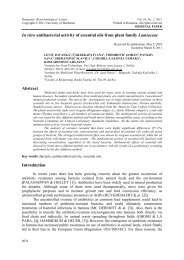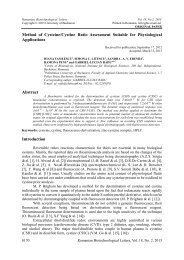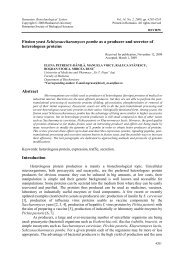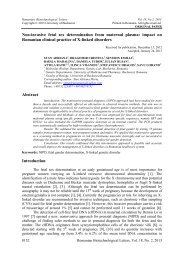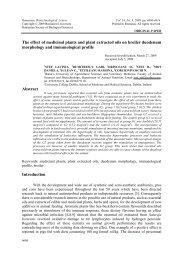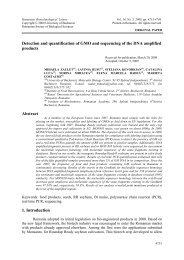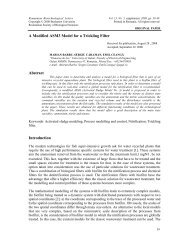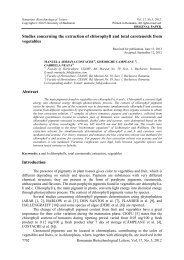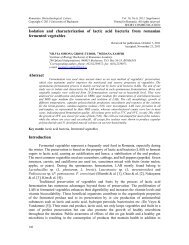Treg in TB CCDiaconu - Rombio.eu
Treg in TB CCDiaconu - Rombio.eu
Treg in TB CCDiaconu - Rombio.eu
You also want an ePaper? Increase the reach of your titles
YUMPU automatically turns print PDFs into web optimized ePapers that Google loves.
Romanian Biotechnological Letters Vol. 17, No. 1, 2012Copyright © 2012 University of BucharestPr<strong>in</strong>ted <strong>in</strong> Romania. All rights reservedORIGINAL PAPERRegulatory T lymphocytes <strong>in</strong> evaluation of the local protective cellularimmune response to Mycobacterium tuberculosis <strong>in</strong> Romanian patientsAbstract6862Received for publication, November 9, 2010Accepted, October 15, 2011DIACONU C. CARMEN 1#* , NEAGU I. ANA #1 , LUNGU RAZVAN 2 , TARDEIGRATIELA 3 , ALEXIU IRINA 1 , CHIVU ECONOMESCU MIHAELA 1 , BLEOTUCORALIA 1 , BUMBACEA S. ROXANA 4 , ALDEA IOANA1 , MATEI LILIA 1 ,DRAGOMIR NECULA LAURA 1 , PELE IRINA 2 , DRAGU DENISA 1 , STANCU I.COSMIN 1 , NASTASIE ALINA 1 , ATAMAN MARIUS 1 , BUMBACEA DRAGOS 21 Antiviral Therapy Department, Stefan S. Nicolau Institute of Virology, Bucharest,Romania2 Department of Pulmonology Department, Marius Nasta Institute of Pulmonology & CarolDavila University of Medic<strong>in</strong>e and Pharmacy, Bucharest, Romania3 Laboratory of Virology, Immunology and Molecular Biology, Victor Babes Hospital ofInfectious and Tropical Diseases, Bucharest, Romania4 Allergology and Cl<strong>in</strong>ical Immunology Department, Elias Emergency University Hospital& Carol Davila University of Medic<strong>in</strong>e and Pharmacy, Bucharest, Romania# These authors contributed equally to this study*Correspond<strong>in</strong>g author: Carmen C. Diaconu PhD, Antiviral Therapy Department, Stefan S.Nicolau Institute of Virology, 285 Mihai Bravu, Bucharest, 030304, Romaniatel: 0040742544320; fax:0040213242590e-mail: ccdiaconu@yahoo.com, carmen.diaconu@virology.roActive suppression by Regulatory T lymphocytes (<strong>Treg</strong>) might be important <strong>in</strong> controll<strong>in</strong>gimmune responses aga<strong>in</strong>st Mycobacterium tuberculosis (Mtb). Our aim was to evaluate the localcellular immune response to Mtb, by evaluation of <strong>Treg</strong> cells <strong>in</strong> pl<strong>eu</strong>ral fluid (PF) compared toperipheral blood (PB) from patients with active Mtb <strong>in</strong>fection and healthy Romanian subjects.<strong>Treg</strong>s were isolated us<strong>in</strong>g MACS CD4 + CD25 + CD127 dim/- (Miltenyi) and CD4 CD25 Tcells and Foxp3 transcription factor were analyzed by flow cytometry. We found higher % of <strong>Treg</strong>s<strong>in</strong> PF compared to PB from patients or healthy Romanian subjects, which might expla<strong>in</strong> therelatively effective local immune response aga<strong>in</strong>st Mtb <strong>in</strong>fection.Keywords: RegulatoryTcells, CD4+CD25+FoxP3+, Mycobacterium tuberculosis, pulmonarytuberculosisIntroductionTuberculosis rema<strong>in</strong>s one of the most deadly diseases <strong>in</strong> the world affect<strong>in</strong>g anastonish<strong>in</strong>g number of the world’s population. It is estimated that each year more than 9million new cases of tuberculosis occur and approximately 2 million persons die from thedisease [1]. N<strong>in</strong>ety-five percent of the tuberculosis cases occur <strong>in</strong> develop<strong>in</strong>g countries.Romania is ranked among the first <strong>in</strong> WHO Europe Region with an <strong>in</strong>cidence of115/100.000 <strong>in</strong>habitants.Approximately one-third of the world’s population is latently <strong>in</strong>fected with Mtb and90% of these <strong>in</strong>dividuals will never develop active disease dur<strong>in</strong>g their lifetime, <strong>in</strong>dicat<strong>in</strong>gthat the human immune system is capable, <strong>in</strong> most of the cases, of controll<strong>in</strong>g Mtb<strong>in</strong>fection effectively. However, it rema<strong>in</strong>s elusive why the immune system only restricts
Regulatory T lymphocytes <strong>in</strong> evaluation of the local protective cellular immune responseto Mycobacterium tuberculosis <strong>in</strong> Romanian patientsmicrobial growth and fails to achieve sterile eradication of Mtb. Also, there is a widespectrum of susceptibility to <strong>TB</strong>, even among an immunocompetent population.Regulatory T cells (<strong>Treg</strong>s) are considered among the most <strong>in</strong>formative <strong>in</strong>evaluation of current immune status, controll<strong>in</strong>g homeostasis and immunopathology [2].Effector CD4+T cells of the Th1 type dom<strong>in</strong>ate protective immunity and help tolimit bacterial replication and dissem<strong>in</strong>ation <strong>in</strong> vivo, however it also causessignificant immunopathology. <strong>Treg</strong>s, produced by the thymus, suppress the activation andexpansion of naïve T cells and their differentiation to effector T cells, and appear to becritical <strong>in</strong> controll<strong>in</strong>g immune homeostasis [3].Immunologic reactivity aga<strong>in</strong>st Mtb is compartmentalized <strong>in</strong> pl<strong>eu</strong>ral space,and <strong>in</strong>flammatory cells and mediators are readily found at the site of disease.Active suppression by <strong>Treg</strong>s might play an important role <strong>in</strong> the down-regulation of Tcell responses to foreign and self-antigens, <strong>in</strong>clud<strong>in</strong>g Mtb [4].At this time, little is known about the profile of <strong>Treg</strong> cells <strong>in</strong> patients with <strong>TB</strong>from endemic sett<strong>in</strong>gs as Romania is. If <strong>Treg</strong> cells can be expanded at the site of<strong>in</strong>fection dur<strong>in</strong>g active <strong>TB</strong>, those cells would be able to decrease the immune responseaga<strong>in</strong>st Mtb [5].Our aim was to evaluate regulatory T cells (<strong>Treg</strong>s) at the site of <strong>in</strong>fection with Mtb<strong>in</strong> Romanian patients. Tuberculosis (<strong>TB</strong>) pl<strong>eu</strong>risy is accepted to be a suitable model forevaluat<strong>in</strong>g local protective cellular immune response to Mtb, s<strong>in</strong>ce it can be spontaneouslyself-cured. Therefore, we evaluated <strong>Treg</strong> population <strong>in</strong> pl<strong>eu</strong>ral fluid (PF) and time-matchedperipheral blood (PB) samples from Romanian patients with tuberculous pl<strong>eu</strong>risy (TP),compared to peripheral blood samples from healthy, Mtb un<strong>in</strong>fected <strong>in</strong>dividuals.Results and DiscussionCD4+CD25+FoxP3+ T cells are <strong>in</strong>creased <strong>in</strong> the blood and pl<strong>eu</strong>ral fluids of TPpatients To <strong>in</strong>vestigate whether Mtb <strong>in</strong>fection <strong>in</strong> TP is associated withCD4+CD25+FoxP3+ <strong>Treg</strong> expansion, we monitored their proportion from total CD4+lymphocytes.The percentages of CD4 + CD25 + Foxp3 + T cells <strong>in</strong> PF and PB from patients with TPand, PB from healthy control (Control-PB) subjects were determ<strong>in</strong>ed by flow cytometrybefore (Fig.1) and after enrichment us<strong>in</strong>g MACS CD4 + CD25 + CD127 dim/- (Miltenyi Biotec)(Table 1). The expression of forkhead transcription factor Foxp3 was exam<strong>in</strong>ed both <strong>in</strong>CD4 + CD25 + after first and second positive magnetic selection of the cells, us<strong>in</strong>g anti-CD4-FITC/anti-CD25- PE/anti-Foxp3-APC (Miltenyi Biotec).The results depicted <strong>in</strong> Figure 1 <strong>in</strong>dicate that the frequency of CD4+CD25+FoxP3+ Tcells with<strong>in</strong> the total CD4+ population was significantly <strong>in</strong>creased <strong>in</strong> the PF compared withPB of the patients with tuberculosis (p
DIACONU C. CARMEN, NEAGU I. ANA, LUNGU RAZVAN, TARDEI GRATIELA, ALEXIU IRINA,CHIVU ECONOMESCU MIHAELA , BLEOTU CORALIA, BUMBACEA S. ROXANA, ALDEA IOANA ,MATEI LILIA, DRAGOMIR NECULA LAURA, PELE IRINA, DRAGU DENISA, STANCU I.COSMIN,NASTASIE ALINA , ATAMAN MARIUS , BUMBACEA DRAGOSFigure 1. CD4+CD25+FoxP3+ T cells were <strong>in</strong>creased <strong>in</strong> the peripheral blood (PB) of patients with pulmonarytuberculosis (PT). PBMCs isolated from the blood of healthy donors (PB control, n=5, mean age (range)=34.8 (26-43)), PBMCs and cells from pl<strong>eu</strong>ral fluid from pulmonary tuberculosis patients (n=5, mean age(range) = 36.8 (21-66)) were analyzed for surface expression of CD4 and CD25 and <strong>in</strong>tracellular expressionof FoxP3. Samples were acquired after written <strong>in</strong>formed consent obta<strong>in</strong>ed from the study subjects. The researchproject was approved by the <strong>in</strong>stitutional Ethics Committee. All patients were HIV negative. All sampleswere exam<strong>in</strong>ed for the presence of M. tuberculosis, fungi, and malignant cells. Samples were analyzed byEPICS XL Beckman Coulter or FACSCalibur Becton Dick<strong>in</strong>son.Flow Cytometers. Each dot represents the value for each <strong>in</strong>dividual patient. Differenceamong groups was analyzed us<strong>in</strong>g Student’s T Test and p values were <strong>in</strong>dicated on thefigure. The proportion of CD4+CD25+FoxP3+ T cells with<strong>in</strong> total CD4+ T cells wassignificantly higher <strong>in</strong> PB-TP and PF-TP compared to PB control (p
Regulatory T lymphocytes <strong>in</strong> evaluation of the local protective cellular immune responseto Mycobacterium tuberculosis <strong>in</strong> Romanian patientssecond positive selection (III) purities higher than 90% were obta<strong>in</strong>ed for all<strong>in</strong>vestigated samples and high percentage Foxp3+ <strong>in</strong> these populations confirmed thefact that most of them were <strong>Treg</strong>s (Table1, Fig.2).Percentages CD4 CD25 + Foxp3 + T cell <strong>in</strong> PF were higher than those <strong>in</strong> PB from patientswith TP and healthy subjects <strong>in</strong> this study. We also found that CD4 CD2 T cells <strong>in</strong>filtrat<strong>in</strong>gthe pl<strong>eu</strong>ral space were regulatory T cells s<strong>in</strong>ce they expressed a high level of Foxp3transcription factor.Table 1. % CD4 + CD25 + T cells <strong>in</strong> PF and PB from patients and normal subjects after MACS separation,and analysis of % Foxp3+ <strong>in</strong> the CD4 + CD25 + isolated cellsCD4+CD25+ purity (% of separated cells)Pre-enrichment (I)Enrichment (II)controls PB 55.7+/-27.1 79.2+/-5.4PB from TP patient 58.2+/-18.4 80.6+/-7.5PF from TP patients 85.7+/-4.2 90.1+/-4.5Foxp3+ purity (% of CD4+CD25+ cells)Pre-enrichment (I)Enrichment (II)controls PB 56.62+/-4.9 58.62+/-5.2PB from TP patient 57.6+/-3.7 59.06+/-3.5PF from TP patients 62.64+/-7.0 63.98+/-7.4Separation of the T cell populations was achieved us<strong>in</strong>g MACS CD4 + CD25 + CD127 dim/-(ON130-094-775 Miltenyi Biotec). Non-target cells were elim<strong>in</strong>ated after a magneticlabel<strong>in</strong>g performed us<strong>in</strong>g anti-Biot<strong>in</strong> MicroBeads and biot<strong>in</strong>-conjugated mAb aga<strong>in</strong>st CD8,CD19, CD123, CD127mAb (pre-enrichment). After magnetic separation, CD4+CD127dim/-unlabeled cells were pre-enriched <strong>in</strong> the effluent (I). Further, was performed an enrichment (IIand III) us<strong>in</strong>g MicroBeads conjugated with anti-CD25 mAb. CD4+CD25+CD127dim/- cellswere enriched <strong>in</strong> the effluent and analyzed for CD4, CD25 and Foxp3 the expression.Romanian Biotechnological Letters, Vol. 17, No. 1 , 2012 6865
DIACONU C. CARMEN, NEAGU I. ANA, LUNGU RAZVAN, TARDEI GRATIELA, ALEXIU IRINA,CHIVU ECONOMESCU MIHAELA , BLEOTU CORALIA, BUMBACEA S. ROXANA, ALDEA IOANA ,MATEI LILIA, DRAGOMIR NECULA LAURA, PELE IRINA, DRAGU DENISA, STANCU I.COSMIN,NASTASIE ALINA , ATAMAN MARIUS , BUMBACEA DRAGOSFigure 2. % CD4 + CD25 + and %Foxp3+ <strong>in</strong> samples from control (A) or PB (B) and PF (C) from <strong>TB</strong>patients after MACS separation (second positive selection - III).6866 Romanian Biotechnological Letters, Vol. 17, No. 1 , 2012
Regulatory T lymphocytes <strong>in</strong> evaluation of the local protective cellular immune responseto Mycobacterium tuberculosis <strong>in</strong> Romanian patientsDot plot representation are obta<strong>in</strong>ed from overlay<strong>in</strong>g T CD4 + CD127 - CD25 + cells (here called<strong>Treg</strong> - red) on T CD4 + CD25 - (here called Teffector =Teff - green) obta<strong>in</strong>ed as non-target cellsdur<strong>in</strong>g last positive selection. Teff population was used for gat<strong>in</strong>g Foxp3+ cells as Low et al.[6] recently suggested. CD4 + were gated for analysis of Foxp3 expression. Representative dotplotsfor each type of sample.Higher percentage of CD4 + CD25 + CD127 dim/- obta<strong>in</strong>ed after first positive selection mightbe expla<strong>in</strong>ed by the higher level of CD25 + , which is a characteristic of <strong>Treg</strong>s cells andwas confirmed by the higher percentage of Foxp3 + cells <strong>in</strong> this population. Analysisof the CD4 + /CD25 + purities of the cells obta<strong>in</strong>ed after first positive selection(enrichment II) might be a better modality to assess the percentage of <strong>Treg</strong>s <strong>in</strong> abiological sample.Analysis of Foxp3 + level <strong>in</strong> selected populations was not discrim<strong>in</strong>ative enough for arapid evaluation of <strong>Treg</strong>s <strong>in</strong> <strong>in</strong>itial samples and is more difficult to evaluate, Foxp3be<strong>in</strong>g an <strong>in</strong>tracellular antigen. S<strong>in</strong>ce usually the separated <strong>Treg</strong> cells are necessary <strong>in</strong>subsequent functional experiments, it is important to have a fast reliable method toevaluate the number of these cells <strong>in</strong> the purified samples.At present expansion of <strong>Treg</strong> cells <strong>in</strong> <strong>TB</strong> is still under <strong>in</strong>tense debate.Guyot-Revol and colleagues [7], and others [8, 9] found that regulatory lymphocytes (<strong>Treg</strong>cells) were expanded <strong>in</strong> patients with active tuberculosis (<strong>TB</strong>) from a non-endemic sett<strong>in</strong>g andmay play a role <strong>in</strong> suppression of type 1 immune responses. On the contrary, Gazzola andcolleagues [10] showed no <strong>in</strong>crease <strong>in</strong> CD4_CD25high T cells <strong>in</strong> patients with tuberculosiscompared with healthy control subjects and they highlighted the significance of accurateapproaches to evaluate the frequency and level of FoxP3 expression at the s<strong>in</strong>gle cell level.Our results, obta<strong>in</strong>ed on samples from a sett<strong>in</strong>g with high endemicity, showed a significant<strong>in</strong>crease of the frequency of the CD4+CD25+FoxP3+ T cells <strong>in</strong> TP compared to control.Further studies are required to del<strong>in</strong>eate the role of CD4 + CD25 + Foxp3 + T cells <strong>in</strong> TP andshould be focused on identify<strong>in</strong>g the mechanisms <strong>in</strong>volved <strong>in</strong> the immunoregulatoryproperties of pl<strong>eu</strong>ral <strong>Treg</strong> cells.We presume that an <strong>in</strong>creased percentage of CD4 + CD25 + Foxp3 + T cells <strong>in</strong> PF might be due toactive recruitment or local differentiation. Recent studies showed that both these hypothesisare possible [11]. Therefore, further studies on the mechanisms by which CD4 + CD25 + Foxp3 +T cells were recruited <strong>in</strong>to PE will be very useful.ConclusionsAnalysis of the CD4 + /CD25 + purities of the cells obta<strong>in</strong>ed after first positive selectionmight be a better modality of assessment of the percentage of <strong>Treg</strong>s <strong>in</strong> a biologicalsample than Foxp3 + level determ<strong>in</strong>ation, which will take longer to be performed.The <strong>in</strong>creased level of <strong>Treg</strong> cells <strong>in</strong> tuberculous pl<strong>eu</strong>ral fluid expla<strong>in</strong>s the relatively effectivelocal immune response aga<strong>in</strong>st Mtb <strong>in</strong>fection.AcknowledgementsThis work was supported by CNCSIS–UEFISCSU, projects PNII – IDEI 1447 /2008, TE-100/2010 and PNII - 42-148. Carmen C. Diaconu was supported by the Sectoral OperationalRomanian Biotechnological Letters, Vol. 17, No. 1 , 2012 6867
DIACONU C. CARMEN, NEAGU I. ANA, LUNGU RAZVAN, TARDEI GRATIELA, ALEXIU IRINA,CHIVU ECONOMESCU MIHAELA , BLEOTU CORALIA, BUMBACEA S. ROXANA, ALDEA IOANA ,MATEI LILIA, DRAGOMIR NECULA LAURA, PELE IRINA, DRAGU DENISA, STANCU I.COSMIN,NASTASIE ALINA , ATAMAN MARIUS , BUMBACEA DRAGOSProgramme Human Resources Development (SOP HRD), f<strong>in</strong>anced from the European SocialFund and by the Romanian Government under the contract numberPOSDRU/89/1.5/S/64109.References1. WORLD HEALTH ORGANIZATION - Stop <strong>TB</strong> Partnership. 2010/2011 Tuberculosis GlobalFacts. http://www.who.<strong>in</strong>t/tb/publications/2010/factsheet_tb_2010.pdf . 2010. last accessed 30-11-2010.1. G.A. ROOK, V. ADAMS, J. HUNT, R. PALMER, R. MARTINELLI, L.R. BRUNET.Mycobacteria and other environmental organisms as immunomodulators for immunoregulatorydisorders. Spr<strong>in</strong>ger Sem<strong>in</strong> Immunopathol, 25, 237–255 (2004).2. M.A. CUROTTO DE LAFAILLE, J.J. LAFAILLE. Natural and adaptive foxp3+ regulatory T cells:more of the same or a division of labor? Immunity 30, 626-635 (2009).3. G. OLDENHOVE, N. BOULADOUX, E.A. WOHLFERT, J.A. HALL, D. CHOU, L. DOSSANTOS, S. O'BRIEN, R. BLANK, E. LAMB, S. NATARAJAN, R. KASTENMAYER, C.HUNTER, M.E. GRIGG, Y. BELKAID. Decrease of Foxp3+ <strong>Treg</strong> cell number and acquisition ofeffector cell phenotype dur<strong>in</strong>g lethal <strong>in</strong>fection, Immunity, 31, 772–786 (2009).4. .J. ZHU, W.E. PAUL. Peripheral CD4+ T-cell differentiation regulated by networks ofcytok<strong>in</strong>es and transcription factors, Immunol Rev., 238, 247-262 (2010).5. J.P. LAW, D.F. HIRSCHKORN, R.E. OWEN, H.H. BISWAS, P.J. NORRIS, M.C. LANTERI,The Importance of Foxp3 Antibody and Fixation/ Permeabilization Buffer Comb<strong>in</strong>ations <strong>in</strong>Identify<strong>in</strong>g CD4+/CD25+/Foxp3+ Regulatory T Cells, Cytometry, Part A, 75A, 1040 - 1050 (2009).6. V. GUYOT-REVOL, J.A. INNES, S. HACKFORTH, T. HINKS, A. LALVANI, Regulatory T-cells are expanded <strong>in</strong> blood and disease sites <strong>in</strong> patients with tuberculosis. Am J Respir Crit CareMed 173(7):803-810 (2006).7. R. SAYMA, B. GUDETTA, J. FINK, A. GRANATH, S. ASHENAFI, A. ASEFFA, M.DERBEW, M. SVENSSON, J. ANDERSSON, S. GRUNDSTROM BRIGHENTI.Compartmentalization of Immune Responses <strong>in</strong> Human Tuberculosis Few CD8+ Effector T Cellsbut Elevated Levels of FoxP3+, Regulatory T Cells <strong>in</strong> the Granulomatous Lesions, Am J Pathol,174:2211–2224, 2009.8. N.D. MARIN, S.C. PARÌS, V.M.VÈLEZ, C.A. ROJAS, M. ROJAS, L.F. GARCÌA RegulatoryT cell frequency and modulation of IFN-gamma and IL-17 <strong>in</strong> active and latent tuberculosis.Tuberculosis (Ed<strong>in</strong>b).9. 90(4):252-261 (2010).10. L. GAZZOLA, C. TINCATI, A. GORI, M. SARESELLA, I. MARVENTANO , F. ZANINI, FoxP3RNA11. expression <strong>in</strong> regulatory T cells from patients with tuberculosis. Am J Respir Crit Care Med: 174:356(2006).12. S. RAGHAVAN S., A.M. HARANDI, ‘Help’ from an unexpected source: Polyclonal <strong>Treg</strong>senhance antibody response to mucosal immunization, Immunology and Cell Biology 88: 696–697(2010).6868 Romanian Biotechnological Letters, Vol. 17, No. 1 , 2012



